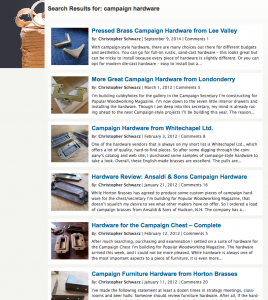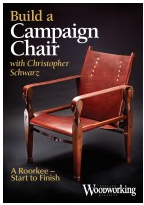We may receive a commission when you use our affiliate links. However, this does not impact our recommendations.
 The question below on campaign hardware came over the transom for Christoper Schwarz. If you’re looking for more info on the subject, click here for the search results on Chris’ blog – he’s written a lot about it, tried out hardware from a number of suppliers, and discussed how to install it.
The question below on campaign hardware came over the transom for Christoper Schwarz. If you’re looking for more info on the subject, click here for the search results on Chris’ blog – he’s written a lot about it, tried out hardware from a number of suppliers, and discussed how to install it.
I have spent months researching campaign hardware, yet remain unable to reach a decision. Though discussed multiple times in various posts, there’s an aspect of it which remains untouched.
Of course there are a multitude of considerations to factor into selecting brass hardware: cast, forged, extruded, lacquered, unsealed, solid brass, brass played, or even the ratio of zinc to copper.
My question is this:
There is such a vast range of brass available; what are the contributing factors that separate the aesthetic quality of polished brass looking luxurious and rich, as opposed to cheap?
— Carrie
Carrie,
“Luxurious and rich” can mean a number of things. To me, it means slightly irregular, mellow and dull. To others it might mean brightly polished and perfectly machined. A lot of the equation depends on manufacturing.
There are four primary ways to make campaign hardware: sand-casting, lost wax, die-casting and stamping/bending.
By definition, die-cast and stamped hardware is going to look perfectly consistent. The parts will generally be a lightweight metal. And they usually have a brassy, glossy finish. To me, these pieces look wrong on a piece of handmade furniture, but that’s pure opinion.
Pieces made using sand casting and the lost-wax process will be heavier and – depending on the machining – look slightly irregular. I prefer these kinds of pieces for handmade furniture.
However, you also have to consider surface finish. A highly polished and lacquered piece can look wrong on a piece, such as a campaign chest. When I order hardware for a special piece, I’ll ask for the pieces to be bare and unfinished. Then I can tone them myself. You also can work with some suppliers, such as Londonderry Brasses or Horton Brasses to produce a finish that you like. (The stock dull finish on Londonderry brasses is my personal favorite for campaign pieces.)
I haven’t done enough research to determine if the alloying agents used to make the copper into brass play much of a factor. To me, if it looks good, it is good.
— Christopher Schwarz
 Ed note: While there’s no brass on a Roorkee chair, it’s just one of the campaign pieces Chris built for his excellent book “Campaign Furniture” (in which you’ll find plenty of brass bits). He filmed a video on the chair build start to finish for Popular Woodworking; you’ll find it in our store as a DVD ($29.99) or as a video download ($24.99). Both include a copy of his PWM article, “Campaign Furniture.”
Ed note: While there’s no brass on a Roorkee chair, it’s just one of the campaign pieces Chris built for his excellent book “Campaign Furniture” (in which you’ll find plenty of brass bits). He filmed a video on the chair build start to finish for Popular Woodworking; you’ll find it in our store as a DVD ($29.99) or as a video download ($24.99). Both include a copy of his PWM article, “Campaign Furniture.”
Here are some supplies and tools we find essential in our everyday work around the shop. We may receive a commission from sales referred by our links; however, we have carefully selected these products for their usefulness and quality.









The metal finishing is the single most important step in producing quality hardware. Poorly finished brasses look lousy no matter how they are made. One thing that matters above all else-solid brass is critical-pot metal with brass plating will never look great. You can’t finish it well (because a quality finishing process will remove the plating), and it won’t last.
The copper zinc ratio makes virtually no difference. Different production processes use different ratios, the finishing process takes care of the slight color variations.
The type of hardware being produced should guide the production methods. Some things are best done via casting, some things are much better done via stamping, machining, etc. Stamped corners and brackets for campaign hardware can be done very well.
Campaign ‘Like’ furniture. I ran across these ‘traveling lighthouse library boxes’ on the Oregon coast.
I wonder who and when these were made. The boxes were put into service in the mid 1800’s and were moved
ever 6 month’s or so from lighthouse to lighthouse to provide reading material for the Light Keepers.
Very rugged box construction and simple wood and finish. These boxes might make a great followup article to
the Civil war furniture and campaign furniture. I have some photo’s if you are interested.